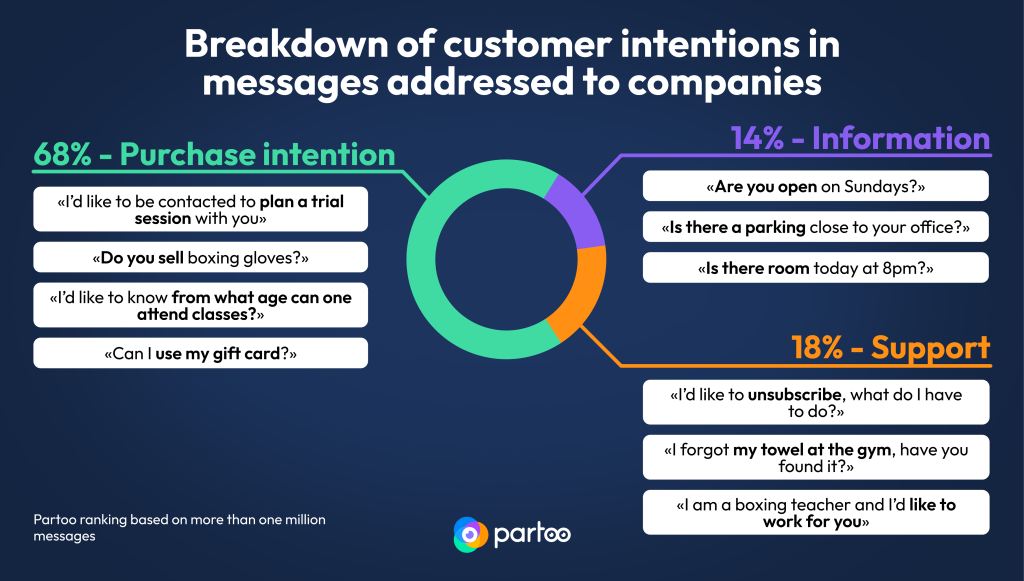Conversational Commerce: The Complete Guide

Table of contents
Conversational commerce is the future of the Internet? Today, 90% of potential customers prefer to send a message to a company rather than call them. Faced with this evolution in the buying journey, companies must rethink their way of communicating and being contacted by Internet users. Discover our practical guide to learn everything about conversational commerce and how to integrate it!
What is conversational commerce?
Conversational commerce refers to the use of messaging, chatbots, and other conversational interfaces to facilitate interactions (and transactions) with your company’s customers.
Indeed, rather than relying on more traditional communication channels such as email or phone, conversational commerce will resort to more instantaneous solutions. Among them, messaging applications like WhatsApp, Facebook Messenger, or Google Business Messages allow you to connect with your customers in a more convenient, personal, and real-time manner. Chatbots or SMS are also possible in a conversational commerce approach.

Did you know?
Nearly 70% of conversations impact the revenue of a business (purchases, reservations…).
Source: Partoo study on over a million analysed messages.
Nearly 70% of conversations impact the revenue of a business (purchases, reservations…).
Source: Partoo study on over a million analysed messages.
Conversational commerce offers companies a powerful way to connect with customers and improve the customer experience. It enables providing fast and personalised service, but also obtaining valuable information about the needs and preferences of your customers.
In this regard, conversational commerce is gradually taking on an important role in the digital strategy of many companies. The average number of messages received by companies using Partoo increased by 400% between October 2022 and October 2023! Furthermore, studies agree on predicting a 100% annual increase in the number of messages received by companies for the next 5 years.
Conversational commerce is thus becoming the new way to sell products and services. By 2025, it is expected to represent 5% of e-commerce!

Fun fact
The term “conversational commerce” is attributed to Chris Messina, who is none other than… the inventor of the hashtag!
The term “conversational commerce” is attributed to Chris Messina, who is none other than… the inventor of the hashtag!
Why switch to conversational commerce?
Now you know, nearly 70% of messages that customers send to companies show a purchase intention. Therefore, conversational commerce has a direct impact on the company’s conversion rate.

Conversational commerce continues to gain popularity due to its numerous advantages:
Advantage #1: Conduct quick and frictionless transactions
Conversational commerce allows for accelerated transactions by offering an interactive and personalised interface between companies and customers.
Through message exchanges, the use of chatbots, or other conversational agents, customers can:
- accelerate their search for information;
- ask questions and receive useful answers in their decision-making process;
- receive tailor-made recommendations;
- book or even pay on the spot.
In short, the entire purchase journey is accelerated!
Advantage #2: Build customer loyalty through an ultra-personalised service
Whether chatting with a member of your team or with artificial intelligence, your client benefits from a personalised experience through conversational commerce.
Even bots using AI are now capable of understanding the context of a conversation and creating a tailored experience, providing relevant responses to queries. This experience suited to the expectations of each client helps strengthen the customer relationship, increase satisfaction, and foster potential customer loyalty.
Conversational commerce can also help your company collect valuable data and information about your clients. By tracking the conversations and interactions you have with them, you can gain a better understanding of the needs, preferences, and behaviours of your customers to offer an even more personalised service. You can then use this information to improve your products and even your marketing strategies!
Advantage #3: Act on upselling, cross-selling and abandoned carts
Conversational commerce also has a significant impact on upselling, cross-selling, and reducing abandoned carts by creating opportunities throughout the customer journey.
Conversations can indeed lead to upselling and cross-selling opportunities by allowing the company to keep track of previous purchases and customer preferences. The company can then offer complementary or more elaborate products or services to the client.
Messaging also allows the company to intervene at strategic moments, which is very useful for reducing the number of abandoned carts. The company can in particular:
- provide instant assistance to resolve a potential issue;
- provide additional information;
- encourage the user to finalize the transaction with a promotional code.
These proactive interactions reduce cart abandonment rates by eliminating potential obstacles, while maximizing opportunities to increase transaction value through relevant and tailor-made suggestions.
Advantage #4: Get the best customer service!
Using certain conversational commerce methods allows you to offer your clients 24/7 assistance.
Furthermore, using a chatbot can help you handle routine requests and tasks to relieve your customer service and allow them to focus on more complex issues and situations.
How to set up a conversational commerce strategy?
Implementing a conversational commerce strategy involves acting on several points to ensure a consistent omnichannel strategy.
Step 1: Define a conversational strategy adapted to the target audience
To successfully implement conversational commerce in your business, you must ensure that the messaging strategy you have in mind is well suited to the needs and preferences of your customers.
To determine their communication preferences and sales channels, create typical profiles (personas) and observe what your direct competitors are doing. Perhaps they have already found the perfect recipe for conversational selling for your target audience!
Step 2: Choose the appropriate messaging platforms
Many tools are available to help you start a conversational commerce strategy. Among them:
Analyse popular messaging platforms where your target audience is likely to contact you: WhatsApp, Instagram, Facebook, Google Business Messages, Apple Business Messages… or any other application specific to your industry. Opt for platforms that naturally integrate into your customers’ daily lives, thus facilitating rapid adoption and smooth interaction.
Integrating SMS into a conversational commerce strategy has a significant advantage: they have an exceptionally high open rate compared to other communication channels. Most people check their SMS almost instantly, so your SMS communications quickly and directly reach your target audience.
Chatbots allow for immediate interaction between your company and the customer. Whether on the website, a mobile application, or a messaging platform, chats are a quick and direct way to answer customer questions, provide real-time information, and solve problems. Do you have a website? Integrating a web chat (or live chat) on your site pages provides your customers with an additional point of contact with your company. A feature that can make a difference if a visitor wants to talk to you after visiting your site!
Voice assistants use voice recognition to allow users to interact naturally with conversation interfaces, without the need to enter text. Voice assistants allow for product searches, placing orders, or requesting information simply by voice.
Live shopping allows your business to dynamically showcase its products through live video sessions, where customers can ask questions, interact with hosts, and even make instant purchases. This approach creates a sense of urgency and authenticity, enhancing customer engagement. By combining the friendliness of live chat with real-time product presentations, live shopping offers an immersive experience that simulates the in-store environment and ensures a high conversion rate.
Step 3: Get help to manage the flow of customer messages!
To effectively manage the flow of messages coming from various platforms, a tool that centralises messages on a single interface is recommended. By consolidating all communication channels, such as social networks, messaging applications, SMS, and chats, you can simplify your management of customer conversations.
Automating certain responses is also very helpful in handling frequent requests. Plus, you ensure 24/7 assistance!
The integration of artificial intelligence, on the other hand, improves the conversational agent’s ability to understand and answer contextually. This results in natural discussions with relevant responses, without any human intervention required.
Switch to conversational commerce with Partoo!
- Partoo centralises all your messages on a single interface
- Automatically reply to the most frequent messages
- Leverage artificial intelligence to reply in just one click in a highly personalised manner!

Switching to conversational converse: How much does it cost?
Integrating free messaging or chatbot solutions may be an option for some businesses, but more advanced and customised solutions often involve costs. The costs associated with a conversational commerce approach vary depending on the tools, platforms, and the complexity of implementation.
Fees may include the development of conversation scenarios, the integration with existing systems, or the cost per click of certain messaging platforms.
However, the benefits in terms of operational efficiency, improved customer experience, and increased sales justify these expenses. It is important to consider these costs as an investment in modernising and optimising customer interactions, which often leads to significant benefits.
In summary:
- Conversational commerce refers to the use of messaging, chat, and other conversational agents in the customer journey to influence purchasing decisions
- This approach offers numerous advantages: streamlined transactions, ultra-personalised interactions, upselling opportunities, and 24/7 accessibility in some cases.
- There are many tools available to switch to conversational commerce: it’s up to you to determine the most relevant one(s) based on your customers’ consumption habits and your company’s objectives!
- Conversational commerce refers to the use of messaging, chat, and other conversational agents in the customer journey to influence purchasing decisions
- This approach offers numerous advantages: streamlined transactions, ultra-personalised interactions, upselling opportunities, and 24/7 accessibility in some cases.
- There are many tools available to switch to conversational commerce: it’s up to you to determine the most relevant one(s) based on your customers’ consumption habits and your company’s objectives!
You are one click away from success
Want to easily develop your business through the Internet? It’s possible thanks to Partoo!
Continue reading ...
Subscribe to our newsletter
Receive our best articles and practical guides directly in your inbox every month


